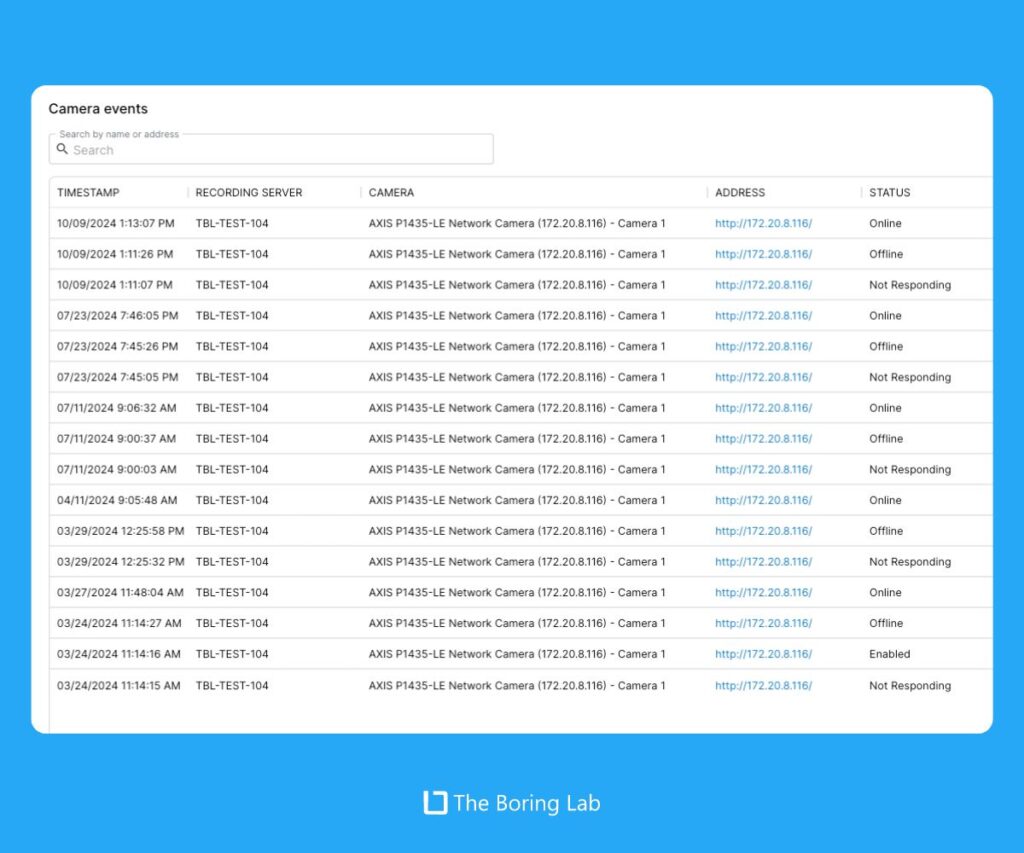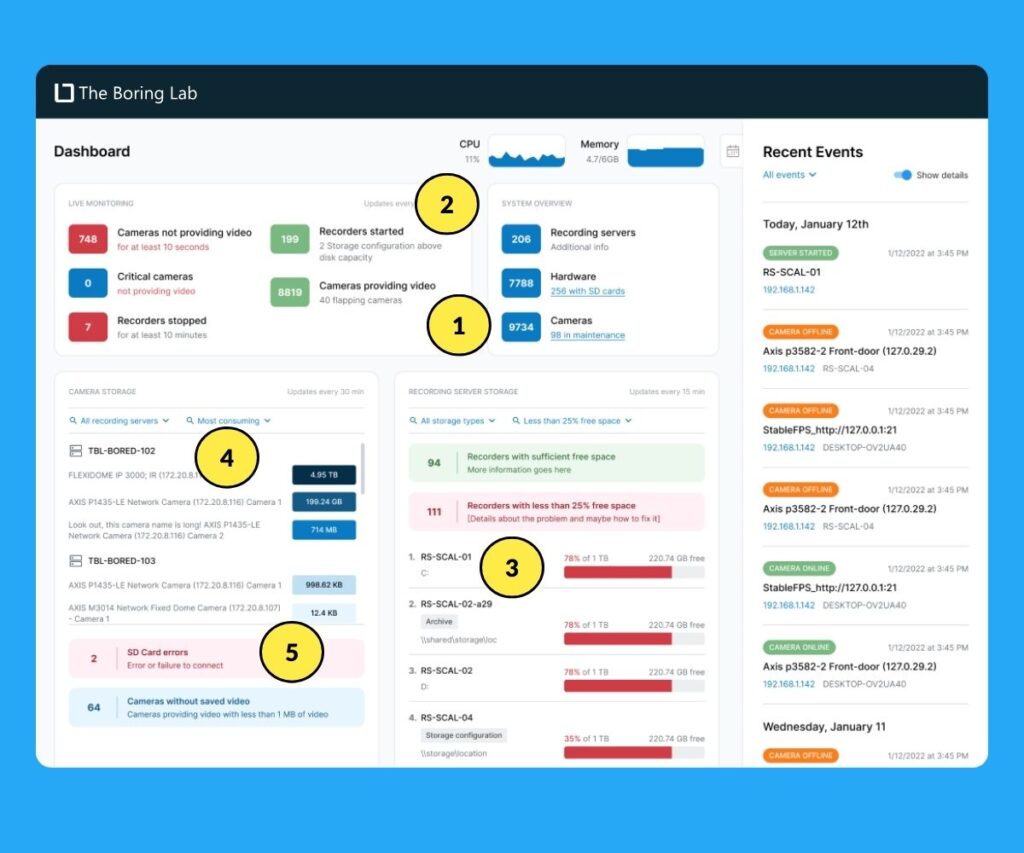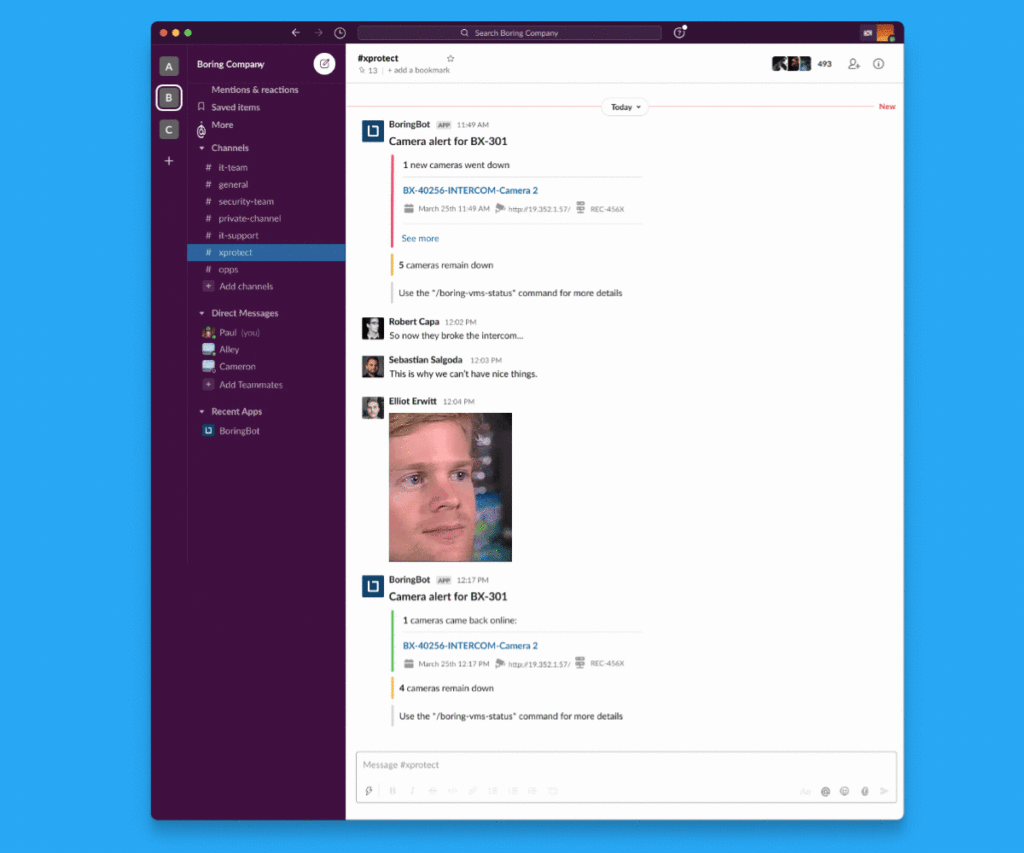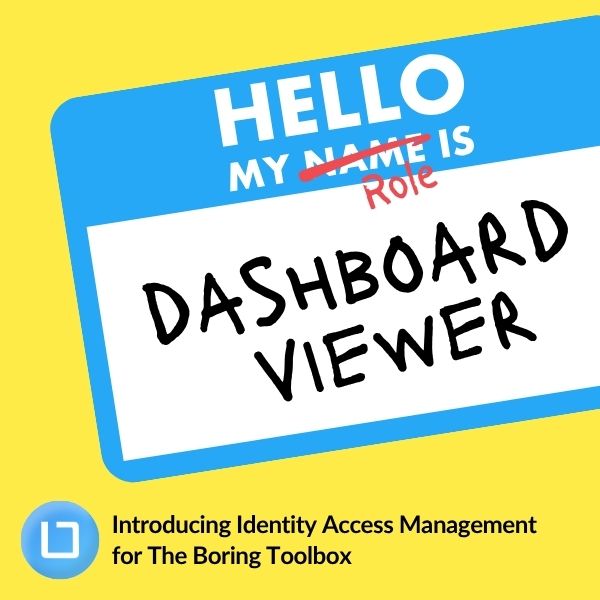
Managing over 240 cameras across a growing city isn’t easy—especially when one person is responsible for it all. See how...
Your VMS is useless if your video isn’t there when you need it.
And the only way to ensure your video is reliably available, is to make sure your system is healthy and working as expected.
But what does that even mean?
To be specific, it means that your cameras are recording, storage has adequate space, system is configured correctly, lenses are clean and free of obstructions, etc.
Instead of spending hours every day manually checking on all of these things, a VMS dashboard offers an easy way to verify if your system is functioning properly or if there are any issues that need your attention.
A VMS, or Video Management System dashboard, is a visual representation of a surveillance system’s overall health and performance. It monitors critical system components such as camera uptime, recording server health, storage capacity, and network performance.
A VMS dashboard eliminates the burden of checking cameras and storage systems manually.
It alerts users to potential issues—like offline cameras, configuration issues, or bandwidth bottlenecks—enabling them to proactively address problems before they escalate or result in lost video.
By providing a clear, at-a-glance view of system health, a VMS dashboard ensures video security operations remain efficient and reliable.
Video security systems are complicated enough.
And while we may have advanced technology like facial recognition and AI video analytics, a lot of the foundational software has not caught up with the rest of the world in embracing the user experience.
This means a lot of our time is spent, as system administrators, on tedious and manual tasks and isn’t always super intuitive.
You will likely need to invest in an add on software like The Boring Toolbox for Milestone XProtect if you want complete visibility into your system health and utilize bulk configuration tools.
Raising our bar to 2024 standards, here are 6 features you should be looking for in a good VMS dashboard.
At bare minimum, a good VMS dashboard should give you real-time data on how many, and which, cameras are down. It should also be able to provide you with historical data for each of those cameras that shows you when it went down and when it came back online.

An add-on like The Boring Toolbox (for Milestone XProtect) is cool because it gives you the ability to tag certain cameras as “critical” as well as put them in “maintenance mode” so you can either mute or draw attention to what’s important in your system.
Being able to see which cameras are down in real-time at-a-glance is a critical piece of this puzzle and will help you address issues quickly and get your cameras back online.
Alerting you to active problems is key but wouldn’t it be great if you had the data to prevent problems before they occurred?
A VMS dashboard should also give you the information you need to be proactive about the health of your surveillance system.
Some helpful metrics include:

This information helps you make data-informed decisions about replacement and maintenance costs, allowing for proactive system care.
It’s 2024, we should be able to see the entirety of your system on one pane of glass. The idea of needing to log into multiple management servers to see what’s happening is inefficient.
Get yourself a VMS Dashboard that consolidates the health data for each of your sites onto one single dashboard.
If you need to narrow your lens and dig deeper into one site or recording server, a good VMS dashboard will have the functionality that allows you to toggle between them as needed.
An interactive dashboard is crucial for digging deeper into your system’s data and making informed decisions quickly.
At a glance, you should be able to click on key metrics—like the number of down cameras—and instantly see a detailed list.
The Boring Toolbox excels here by allowing you to sort these cameras by recording server and click into each one to view full details. This functionality means you can start troubleshooting issues immediately, streamline your workflow, and ensure your surveillance system operates smoothly.
Seamless integrations with collaboration tools like Slack and Microsoft Teams are game-changers for efficient team communication and rapid issue resolution. A VMS dashboard should not only alert you to system and camera issues but also deliver those notifications directly to the platforms where your team is already active.

A great VMS dashboard, like The Boring Toolbox, allows you to receive camera and system alerts, as well as reports, straight into your team’s channels. Even better, you can query real-time VMS status updates without ever leaving Slack or Teams.
This means you can quickly loop in the right people, collaborate on solutions in real-time, and address issues faster than ever before.
When you are looking at VMS dashboard solutions, you really need to consider how it will work in both the near and distant futures.
Near future: how difficult will the dashboard be to set up initially and will it break after each VMS software update.
Distant future: does the dashboard have the ability to scale with your VMS’s growth and does the data flow seamlessly between the two as I add new cameras and recording servers to the VMS?
The answer to those questions lies in how deep the plug-ins integration is with your video management system.
Add-ons aka integrations are not all created equally.
A truly seamless integration with your VMS system will eliminate the need for double entry when adding camera data.
It also ensures backwards and forwards compatibility so you maintain full functionality regardless of software updates to your VMS–preventing the common issue of integrations breaking with new software versions.
As an example, The Boring Toolbox is exclusively built for Milestone using the Milestone MIP SDK This means there will be no hiccups with your dashboard data when Milestone releases a new version, no need to double enter new camera data (up to 10k cameras!), and set up is a breeze.
In 2024, video surveillance systems are more sophisticated than ever, but their complexity can become a burden without the right tools in place.
A powerful VMS dashboard isn’t just a luxury—it’s a necessity for maintaining an efficient and reliable security system. Without it, administrators are stuck manually checking cameras and storage, wasting countless hours, and risking critical downtime.
By leveraging the right dashboard, you’ll have real-time visibility into your system’s health and performance, allowing you to address issues quickly and proactively, before they result in lost video.
We are committed to making The Boring Toolbox the most intuitive and useful VMS dashboard on the market. If you use Milestone XProtect as your VMS and want immediate visibility into your system’s health, sign up for our 30-day free trial today.





It’s the newsletter security professionals use to work smarter. We promise you’ll learn stuff and enjoy a few blissful moments of productive procrastination.

Your go-to XProtect eXPerts. We learn the technical stuff that will save you time and make it less boring.

Your go-to XProtect eXPerts. We learn the technical stuff that will save you time and make it less boring.

Managing over 240 cameras across a growing city isn’t easy—especially when one person is responsible for it all. See how...

This step-by-step guide shows you how to access Milestone XProtect from anywhere using Tailscale. It’s secure, simple, and way less...

Our new Identity and Access Management (IAM) platform makes it easy to manage what your users can see and do...
Subscribe to get a monthly dose of security & surveillance industry news and insights, Milestone VMS time-saving tricks, tips for hacking your way out of boring work sent directly to your inbox!